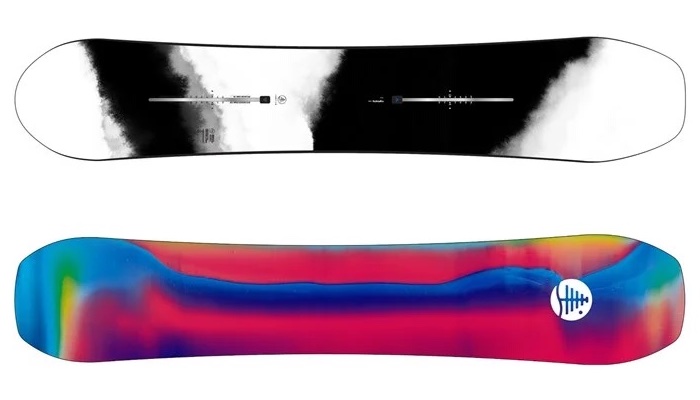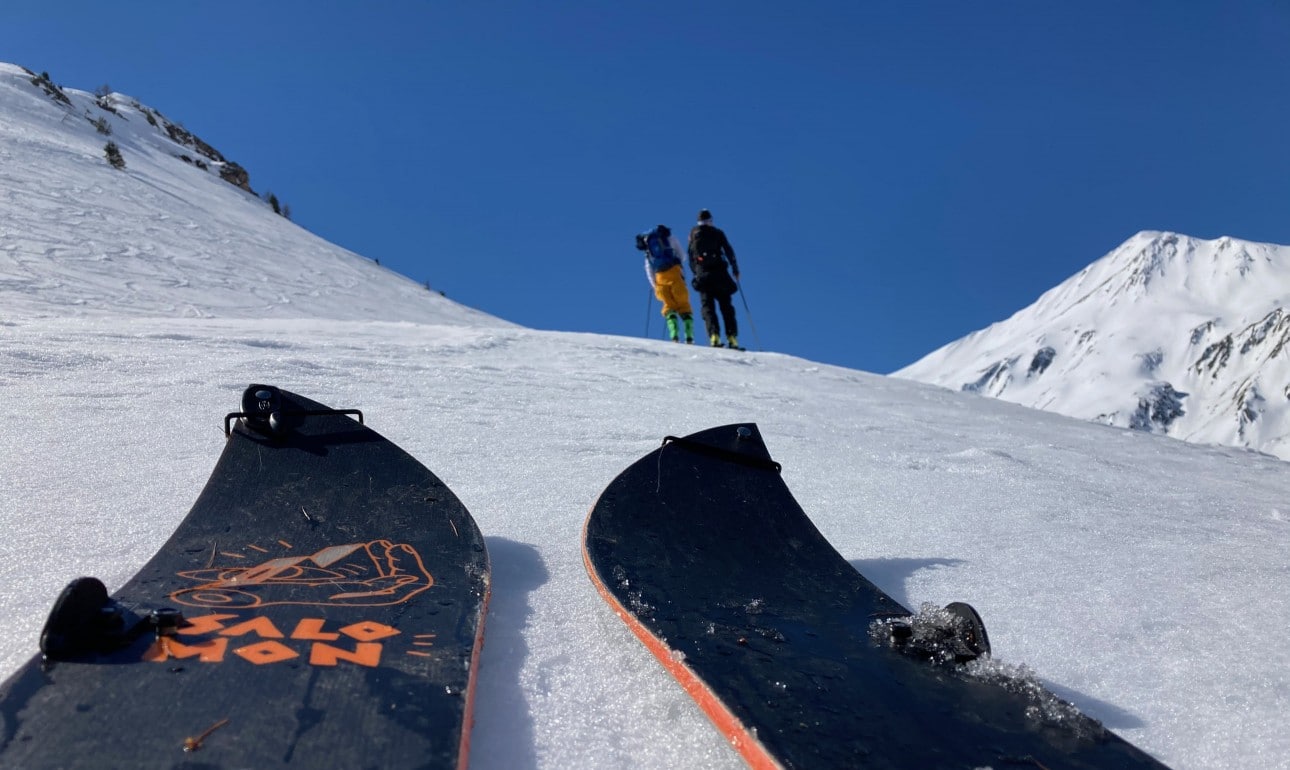Riding powder is the best thing you can do on a snowboard. Floating through powder is a feeling which is hard to beat, so you want to make sure you’ve got a board that is up to the job. Whist powder-specific boards are amazing in the right conditions, they aren’t the most versatile snowboards when it comes to riding park or hardpack groomers.
So before you rush out and buy one, I would only get a powder-specific board if you have other boards you can ride on a non-powder day or if your local mountain gets 40+ feet of snow a year!
Don't know what size snowboard to get? Try out our snowboard size calculator to help take the guesswork out of finding a new board.

Jones Mind Expander

Burton Hometown Hero

Ride Berzerker

Burton Deep Thinker
Rocker Type
Surf Camber
Directional camber
Directional extra camber
Directional camber
Stiffness
6/10
6/10
8/10
6/10
Price
$570
$670
$580
$640
Buy Now
Do You Need a Powder-Specific Snowboard for Riding Powder?
You can definitely ride powder on almost any snowboard, but you will definitely have more fun on a powder board. On a standard kind of freestyle shape, you might find that you struggle when it gets really deep, especially if you are trying to learn to ride powder. Powder boards will give you more float meaning that you don't need to load up the tail of the board so much, which can get really hard work for your back leg after a while.
Check out my post on volume shifted boards for an alternative shape and feel of powder boards.
What Makes a Good Powder Snowboard?
There are 4 characteristics that all good powder boards have, which help the board plane up over the snow, making the boards less effort and more fun to ride.
Snowboard length
Longer boards create extra lift in powder because they have a greater surface area. It also helps because they have a longer nose which planes up above the snow like a surfboard does in water. This can be particularly handy when landing jumps or drops so the nose doesn't sink under the snow, flipping you forward.
Directional shape
A directional shape means that the board is shaped to ride better forwards than backwards. This normally means that the binding mounts and the waist of the board are setback towards the tail. This makes the tail of the board sink a little bit lower in the snow than the nose, helping the board to plane up and float over the powder. Directional shapes are easier to turn and push the snow around with your back foot.
Rocker Profile
Powder boards can come with different rocker profiles but they should all have an earlier rocker in the nose of the board. This means that forward of the front binding, the board starts to curve up, lifting the nose. Rocker helps to prevent catching the nose in the snow and means you can ride with your weight more on both feet with less leaning onto the back foot required.
What goes on between the bindings also has a big effect on how the board handles. Camber between the feet gives more stability and pop and will be better at high speeds and in variable snow. Full rocker boards are more maneuverable and quicker to turn, so great for riding Japan or BC tree lines.
Snowboard Taper
The taper of a snowboard is how wide it is at the nose compared to the tail, so for example a board with a 6mm taper will have a nose which is 6mm wider than the tail. The taper increases the surface area of the nose and reduces the surface area of the tail, helping it to sink low in the back and ride up out of the snow in the front.
Many taper boards are described as having a fish shape, which is a term borrowed from surfing, where these boards are easy to catch waves and maneuver. Like in surfing, if you pick a snowboard with lots of taper and rocker, then you can ride a shorter length which is better suited to quick turns like you need when riding in the trees.
My Pick of the Best Powder Snowboards in 2025
How I picked these boards
These boards are all-round powder boards. They all meet the above requirements and they are all great in every type of terrain – as long as its covered in 2+ feet of pow! I've deliberately stayed away from fish shape or volume shift boards, which are short boards with loads of taper.
Although these powder-specific boards can be super fun to ride, they aren’t great for big open powder fields and doing big, high-speed powder turns. In my opinion, you should only add a fish to your quiver after you’ve already got a board like one of the following.
You can read my review on the best volume shift boards here.
For the design of this board freeride legend, Jeremy Jones teamed up with surfboard shaper Chris Christenson to produce the ultimate feeling of float through the powder.
The basic shape of the board is a directional, with a 7mm taper, rocker in the nose and a slight camber between the bindings.The feel of riding this board might be effortless but there's whole bunch of thought and development gone into achieving that.
The turn radius tightens as you move along the edge from the contact point at the nose toward the tail. This delivers smoother turn initiation and extra power at the bottom of the turn as the edge tracks in and out of the snow.

Directional flex
The board is slightly softer in the nose to help absorb shocks, then more rigid between the binding for increased stability under foot.
Transaction tech edges
The edges of the board are slightly wavey like a serrated knife. This increase the effective edge length and offers more grip when you hit an unexpected patch of hard snow
3D contour base
This innovative shape gives the base a kind of spoon form in the nose and tail, which helps push the snow out to the sides of the board and away from the edges. The effect is a board that is super smooth in the turn and extra floaty in the powder.
This board has been seen a lot last winter strapped to the feet of the Burton team riders. Burton have made the smart move of making this a unisex board meaning they produce a range of sizes so that both men and women can ride it.
The directional camber gives a camber section between the feet and an early rocker in front of the front foot to raise the nose out of the snow. This float is magnified by 12mm of taper, meaning the nose is wider than the tail.
This directional design means that the board only needs a small amount of setback in the binding mounts. This really helps when riding on harder snow and the groomers when you want more of a balanced overall shape.
Through the middle of the board, the glass fibers have been laid in a pattern to facilitate foot steering, making the board easy to maneuver at lower speeds. This makes it perform really well when laying down tighter turns in the trees or in a narrow couloir.
Core
Burton's Super Fly II™ 700G Core gives a super strong and lightweight construction with plenty of pop to give the board energy out of the turns.
The Ride Berzerker is the board of choice for freeride legend Jake Blauvelt who has a smooth, creative style any rider would want to emulate. This board is relatively stiff compared to the other boards on the list, making it a great choice for a more advanced or heavier rider who likes going fast!
Early Rocker
It has camber between the bindings and an earlier rocker at the front, lifting the nose of the board. A small amount of taper from tip to tail helps give extra flat.
Progressive sidecut
Along the edges of the board, there is a quadratic sidecut, meaning the turning radius starts off mellow at the front for easy turn initiation, then tightens towards the back of the board for extra control and power through the turn.
Carbon reinforced
This board is given extra liveliness thanks to its carbon rods placed in the tip and tail. This technology adds pop without the stiffness generally associated with snappy boards, making it fun and easy to ride.
It was designed by another super smooth backcountry rider, Danny Davis. It has a directional shape and setback stance, giving a longer nose to float over the snow. The rocker in front of the front binding lifts the board further, whilst camber between the feet gives stability in turns and plenty of pop for ollies.
Burton call the camber of this board balanced freeride, meaning until you leave the hardpack and are actually freeriding in powder, the board rides like a twin tip.

A 7mm taper from tip to tail helps the board sit back in the snow and allows you to ride with more weight on both feet.
Overall the board is not too stiff, making it easy and fun to ride, but still has plenty of pop when you need it. A great freeride option for Burton enthusiasts who want a more versatile board than a pure powder stick!
Wrapping Up
You don’t need to be a backcountry pro to enjoy riding powder—but having the right board makes it a whole lot more fun. Whether you’re just starting to explore soft snow or looking for something more playful than your daily driver, the boards we’ve picked offer great float, control, and that smooth, surfy feel.
From directional shapes to wider platforms, each one is beginner-friendly without holding you back as you progress. If you’re chasing those deep days, any of these boards will help you make the most of them.




